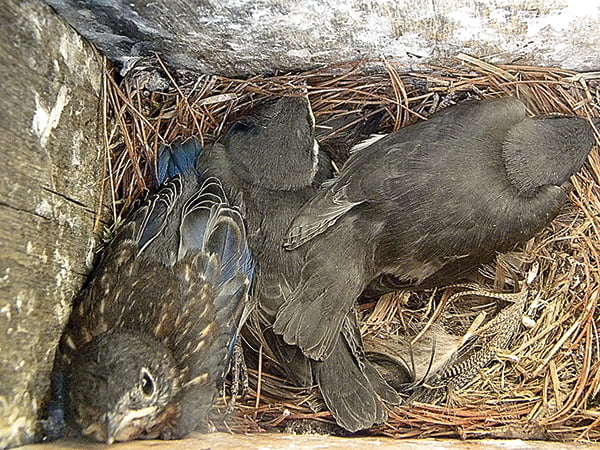
Dave Curry
Contributing Writer
A couple of weeks ago, we left you with a cliffhanger and a question of what would happen to our nest of mixed bluebird and tree swallow eggs. As Paul Harvey used to say, here is “the rest of the story.”
To review a little, on May 18 while monitoring several birdhouses at the Green Bank Observatory, we found one box with mixed eggs. Cavity nesters regularly joust for the best nesting site, so we began to piece together the story. It appeared that a pair of bluebirds had built a nest and laid three eggs. They were then run off by a pair or several tree swallows who did not eject the eggs as they usually do. Instead mama tree swallow laid two eggs of her own and began brooding all five.
This is somewhat unusual and something that I have not observed before in the last 11 years.
The check on May 21 and 28 showed the female tree swallow sitting tightly.
On June 3, four out of five eggs were found to have hatched out, with one bluebird egg not hatching. Two of the naked young were slightly bigger than the other two, with the bigger ones probably being blues.
Follow-up checks on the June 5 and 10 showed them progressing nicely. The next check on the 17th revealed all the young were fully feathered and ready to go. In fact, only three birds were present as one blue had already fledged. All are assumed to fledge within the next day or two.
Adoptions in the bird world are not that unusual. In fact, some birds depend on it and are known as brood parasites.
The brown headed cowbird is best known in this country as a nest parasite, preferring to deposit one egg at a time in other bird’s nests. The cowbird has no mothering skills but will spend a great deal of time watching and observing other birds, waiting for just the right opportunity to slip into a nest and leave her egg.
Many bird species will recognize a dumped egg, one that is not their own, then abandon the nest entirely. While others – more than 200 species have been found with cowbird eggs in their nests – will not notice the difference and will proceed to brood and raise the young as their own. Not hard to imagine the mother bird returning to the nest after foraging for food and finding a much larger, possibly different colored egg in her nest. Her thoughts may be something like “did I do that” or maybe “how many eggs were there?”
Birds are probably not known for their counting skills.
This can often be a detriment to the host species as the young cowbird is often bigger, more advanced, gets the most food, and kicks out or starves host young from the nest.
By the way, cowbirds have never entered the boxes used by my cavity nesters. If the opening is no more than 1.5 inches in diameter, cowbirds can’t get in.
So, there you have it.
All is well that ends well.
Unusual, but a good result.
So, how unusual is it? In a nearby birdhouse, a tree swallow took over a house wren nest and is now brooding two of her eggs and one wren egg.
It’s happening again. Are tree swallows evolving a change of heart? Stay tuned.


